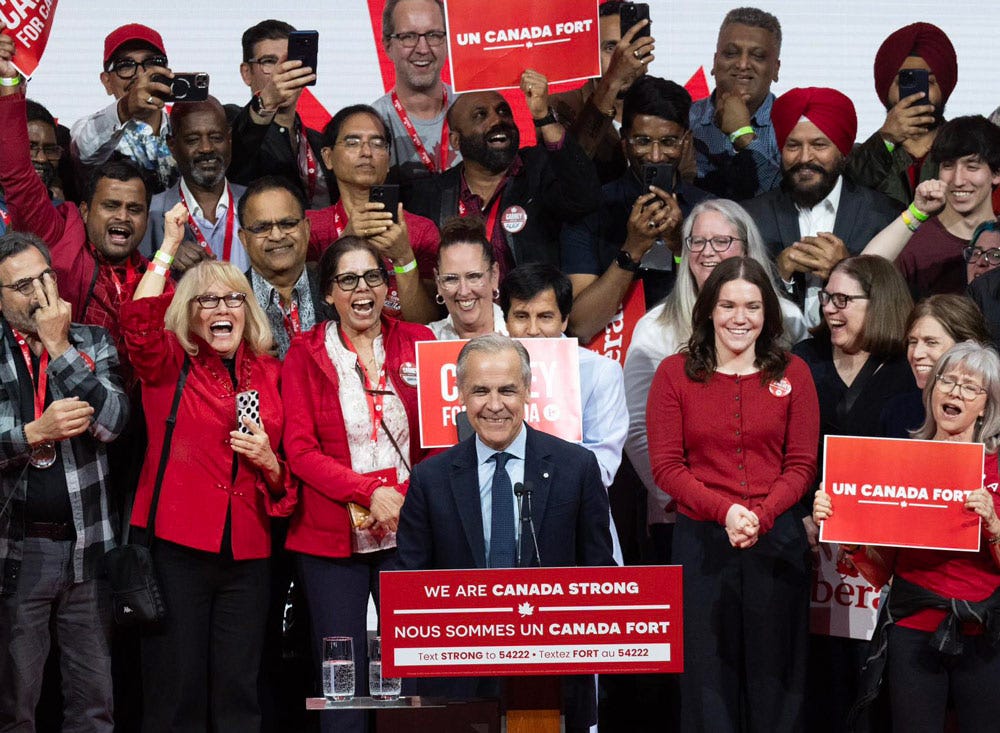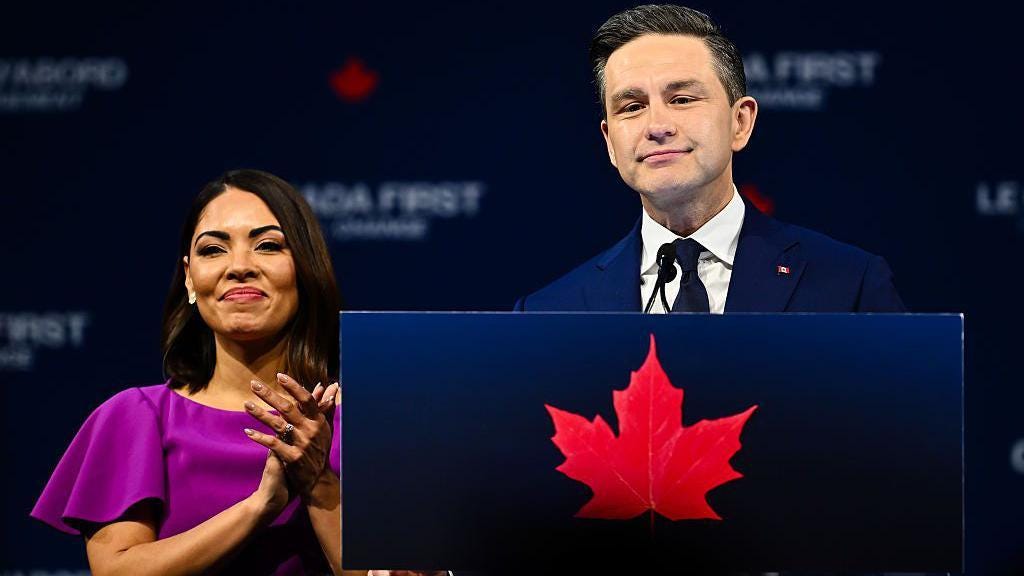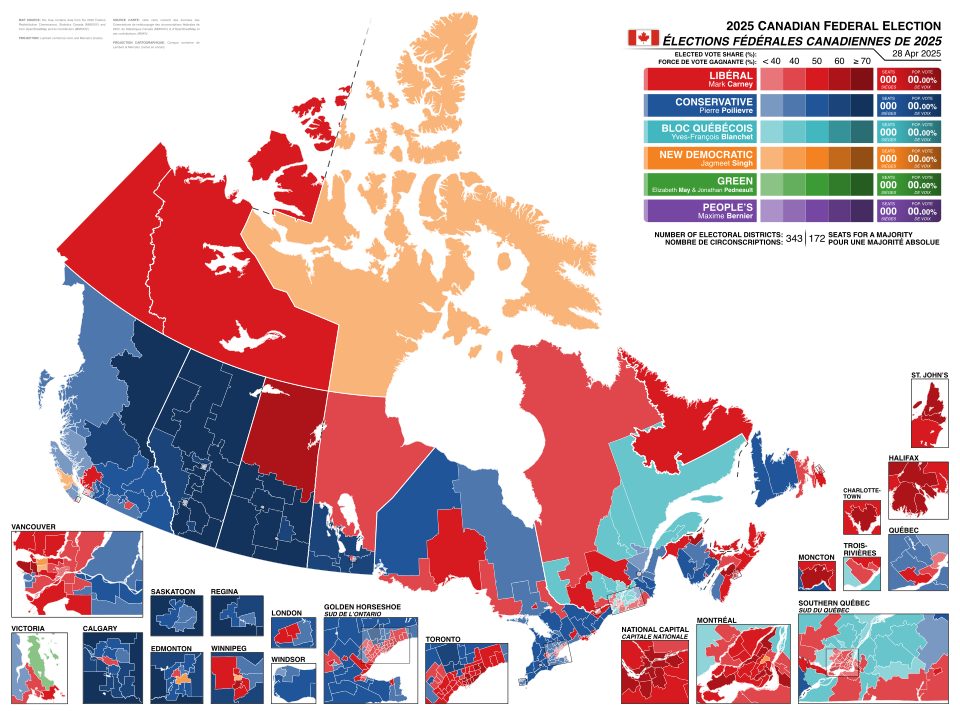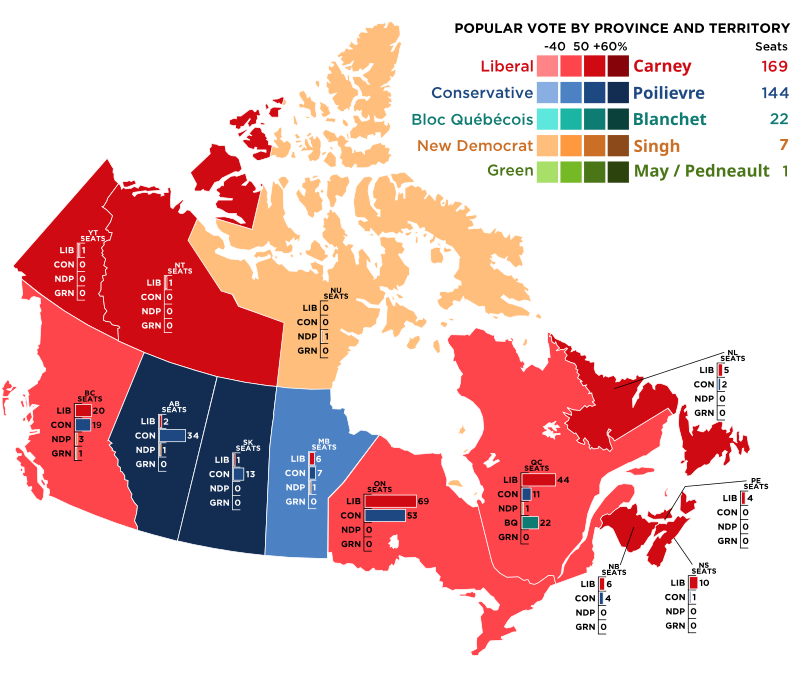It's Springtime For Liberals In Canada
Donald Trump Tanked What Was Supposed To Be An Easy Conservative Comeback

At the beginning of this year, the leader of Canada’s Conservative Party, Pierre Poilievre, was measuring the drapes in the Prime Minister’s office in Ottawa. Now, he won’t even be returning to Parliament.
It was a stunning collapse in political fortunes for him and his party, as well as a remarkable turnout for the Liberal Party of Canada, which has governed the country since 2015 and, in recent years, has become politically toxic under the leadership of former Prime Minister Justin Trudeau.
After facing a 30-point deficit in polls as recently as January, Trudeau’s successor, Prime Minister Mark Carney, led his party to a fourth straight victory on Monday, finishing just shy of enough seats to form a majority government. Still, with 169 seats, the result is the best for the Liberals since their first win in 2015. They also won just shy of 44 percent of the popular vote, the best result for any party since 1984.
With the left-wing New Democratic Party, which lost 17 seats and its official party status, ending with just a caucus of seven, and the lone Green member, Elizabeth May of British Columbia, the new parliament will remain ideologically majority center-left to left-wing.
Political observers were stunned in February when the Liberals not only erased their unprecedented deficit against the Tories, but also took the lead in polls and built a sometimes sizable one after Carney called for a new election in late March. The inflection point came mid-winter when Donald Trump took office as President of the United States, pushing his idea that Canada should be annexed by the United States as the 51st State and threatening to upend more than a century of economic cooperation with tariffs on America’s second-largest trading partner and northern neighbor.
Before his election in November, Trump’s right-wing populist movement seemed to be gaining momentum in Canada as backlash built from years of Trudeau’s left-wing governance. It culminated in backlash to Trudeau’s social agenda, which won the ire of free thinkers online, such as Jordan Peterson, and the COVID-19 Pandemic, where a convoy of truckers descended on Ottawa to protest COVID vaccine mandates.
Then, as he often does, Trump ruined it all. His attacks on Canada reignited a patriotic spirit that Poilievre, who, before Trump’s election, seemed amenable to Trump’s right-wing populist movement, got caught in the shifting political winds. Trudeau resigned in February, and his party chose Carney, a banker and technocrat who didn’t hold elected office, to be the new Prime Minister and Liberal leader. With the unpopular Trudeau out of the way, Liberals could focus on Poilievre and his party. They argued that he is too ideologically aligned with Trump to be willing to stand up to him.
Indeed, all the party leaders, even Poilievre, spoke about the need to stand up to Trump in their speeches on Monday Night, a sign that even the defeated Conservative leader recognizes Canada’s experimentation with Trump’s flavor of populism is over, at least for now. The far-right People’s Party of Canada, which ran on a platform close to Trump’s, finished with less than 1 percent of the vote nationwide despite being led by Maxime Bernier, a former Foreign Minister in Conservative Stephen Harper’s government.
Conservatives can take solace in knowing that they secured 41 percent of the vote, the most significant percentage the party has garnered since the 1980s. They also performed very well among young Canadians and specific immigrant communities, notably in the key suburbs of Toronto, as well as in some rural ridings where they had previously performed poorly. That is despite Poilievre losing his seat in the Ottawa suburbs. In his concession speech, Poilievre did not step down as party leader. He doesn’t have to be in Parliament to lead it. Rumors are circulating that a Tory member in a safe district might resign, allowing him to run in a by-election and return to Parliament. Poilievre, originally from Alberta, may choose to run there instead of in the Ottawa area, where he has represented his constituency since 2004.
Both the Liberal and Conservative parties secured over 40 percent of the national vote, a feat unprecedented in Canada’s multi-party system for almost a century. This has led to concerns that the country is polarizing into a two-party system, similar to the United States. Canada elects its members of Parliament in a “first past the post” system, where the winner can win with a plurality instead of a majority. This system disincentivizes third parties because they could split the vote in a constituency, potentially leading to a win for a candidate who is not ideologically aligned with their constituency. In this election, the Liberal Party sought, with mixed results, to flip left-wing NDP voters in NDP districts to maximize Liberal representation of left-leaning ridings.
As of Wednesday, April 30th, all 343 ridings across the country have been declared, though two with margins of less than 50 votes will be recounted. Here is a roundup of the results, along with some analysis to accompany them.
ATLANTIC CANADA
Early in the night, things didn’t seem to be going well for the Liberals, who had been projected in recent polls to win a majority government easily. Liberals lost a seat in Newfoundland – Long Range Mountains, which they had held since its creation in 2015. This part of Newfoundland was typically a stronghold for them. They also failed to pick up the Central Newfoundland seat they lost in an upset in 2021. Terra Nova—The Peninsulas, a competitive Newfoundland riding, went to the Liberals by just 12 votes. A judicial recount has been ordered.
At one point, it seemed as if Tories could win as many as 10 seats in the provinces of Atlantic Canada, where Liberals swept every seat in the 2015 landslide that brought Trudeau to power. However, the Newfoundland seat was ultimately the only one the Conservatives picked up, and the party lost two Nova Scotia seats – Cumberland—Colchester and South Shore—St.. Margaret’s, both of which the Tories flipped in 2021.
Late-reporting votes from the “advance vote” – Canada’s term for early voting – helped Liberals make up the deficit. Sean Frazier, the Liberal MP from Central Nova in Nova Scotia, was handily reelected despite trailing in early numbers. Frazer has been a prime target of scorn from the Canadian Right over immigration policy due to his time as Trudeau’s Minister of Immigration, Refugees, and Citizenship.
Liberals kept every seat in Prince Edward Island, a stronghold for the party, and came within a few hundred votes of every seat in Nova Scotia, where Conservatives are sometimes strong in non-Liberal waves. Liberals won the popular vote in all four Maritime Provinces by double digits, cementing the region as a base of support.
QUEBEC
Often a wildcard in national elections, Quebec delivered the Liberals a massive win, at the expense of the one-dominant NDP and the Bloc Québécois, a regional party that often plays kingmaker in close parliaments. Liberals won the popular vote by 15 points over the second-place Bloc Québécois (BQ), which finished just ahead of the Conservatives. BQ lost 11 seats to the Liberals, seven in and around Montreal; they also lost one rural seat to the Conservatives, reducing their caucus to 22. Liberals gained a seat in BQ’s stronghold of Quebec City, and won the riding of Trois-Rivières, where more than 93 percent of residents speak French as a native language.
Another seat the BQ lost was the expansive rural Abitibi—Baie-James—Nunavik—Eeyou riding in Northern Quebec, which the Liberals picked up for the first time since 2000. BQ also lost the competitive Châteauguay—Les Jardins-de-Napierville riding, which stretches from Montreal’s southern suburbs to the American border with New York. Trade with the United States is key to the region’s economy, and the tariff issue played a significant role.
The Bloc did knock off Liberal MP Diane Lebouthillier in the rural Northeast Quebec riding of Gaspésie—Les Îles-de-la-Madeleine—Listuguj. This result came early, along with the Liberal defeat in Newfoundland, which for a time worried Liberals and excited Conservatives.
Liberals kept all of their other Quebec seats and increased their vote share in most of Montreal, likely due to NDP voters moving toward them. The NDP did keep the Montreal riding of Rosemont—La Petite-Patrie. Alexandre Boulerice has held the seat since his party dominated in Quebec in the 2011 election. He is the last NDP member from the province.
For a while, there was some concern about Liberal MP Anthony Housefather, who ultimately won by 10 points in his typically safe Mont Royal riding in Montreal. He had trailed his Conservative challenger for much of the night. His 10-percent majority is much reduced from Housefather’s previous election, perhaps due to backlash to anti-Israel protests in Montreal in the heavily Jewish constituency. Liberals have held Mont-Royal since 1940, and it was the seat of former Prime Minister Pierre Trudeau, Justin’s father, during his premiership in the 1970s and 1980s.
ONTARIO
Late in the campaign, Conservatives boasted that their polling showed the race much closer than public polling indicated, especially in Ontario, the country’s largest province. Governed by a popular Conservative government headed by Premier Doug Ford, the Tories had hoped to leverage Ford’s popularity to win the province by focusing on the failures of left-wing crime and housing policy in Toronto. The strategy seemed to be working before Trump intervened.
Ford himself lobbed subtle criticism at Poilievre for not being willing to confront Trump, something Ford had no problem doing directly. Ford even refused to endorse and campaign for Poilievre. Some prominent Conservatives, like MP Jamil Jivani, a longtime friend of JD Vance, blasted Ford, alleging that his open conflict with Trump and criticism of national Conservatives sabotaged the party by undermining them in the country’s largest province. Nearly 4 in 10 Canadians live in Ontario, so a close race in this province makes any national race tighter. Ultimately, Liberals won the province by about five points.
Ontario’s population is primarily located in the “Golden Horseshoe,” the metropolitan area that radiates from Toronto, the country’s largest city, around the western shore of Lake Ontario to Hamilton and Niagara Falls. Conservatives put a heavy focus on the issue of crime, drugs, housing, and problems with immigration in and around the city of Toronto. The city’s mayor, Olivia Chow, is the widow of former NDP leader Jack Layton. Chow’s leftist policies in Toronto have become a lightning rod for right-wing criticism. Similar to what Republicans did in the suburbs of American cities like New York and Detroit, which led to right-wing shifts there, Conservatives used Chow’s social policies, tying the NDP and Liberals together as part of a “coalition,” as a weapon in suburban ridings.
Despite Liberals winning bigger margins in most Toronto ridings due to NDP voters crossing over, more than a dozen Liberal MPs were defeated in Ontario, mainly in the suburbs of Toronto. The swing ridings of Newmarket—Aurora and Richmond Hill South, which have voted for the party that won the national election in every election since 2011, flipped to the Tories, as did Aurora—Oak Ridges—Richmond Hill and Markham—Unionville. Liberals appear to have lost eight seats in the Toronto suburbs, notably the riding of York Centre in Toronto itself. York Centre has a large Jewish population, and the perception that Liberals were too dismissive of antisemitism may have swung voters here as it did in Mont Royal in Quebec. In Brampton West, northwest of Toronto, Liberal Health Minister Kamal Khera lost her seat.
In the Hamilton East—Stoney Creek riding in Hamilton, the Tories defeated Liberal MP Chad Collins. The Conservative Party has not held the seat or any of its predecessor ridings since the 1960s.
Liberals made up for their losses by picking off key Tory seats around the province, most notably the riding of Carleton in the suburbs of Ottawa. This was Poilievre’s seat. He lost in an upset against Liberal candidate Bruce Fanjoy despite representing the constituency since 2004. Prime Minister Carney won a seat - his first electoral win - in the constituency of Nepean, bordering Carleton. Poilievre represented part of the Nepean riding in a previous version in the 2000s. Liberals saw their vote share increase significantly in all Ottawa ridings, perhaps thanks to Carney's coattails or a local backlash against the Right stemming from the chaos of the “trucker convoy” that descended on the capital in early 2022.
The other two flips Liberals gained in Ontario came from two seats they lost to the Tories in 2021: Peterborough and Bay of Quinte, located on the shores of Lake Ontario. Liberals were also able to win back the riding of Toronto-St. Paul’s in the city of Toronto. They lost the seat in an upset win by Conservative Don Stewart last summer in what was widely seen as a sign of the Liberal Party’s catastrophic decline and impending landslide loss. Leslie Church, who lost the by-election by just two points, picked up the seat, defeating Stewart by over 20 points.
However, the strategic voting plan among left-wing NDP and Green Party members to cross to the Liberals to prevent the Tories from winning ultimately backfired in several seats. The Greens lost the Kitchener Centre seat to the Conservatives because the left split their vote among the Greens, Liberals, and the NDP. Some NDP voters in Ontario appeared to have shifted their support to the Conservatives rather than the Liberals, despite the NDP being a left-wing party. In Kitchener South-Hespeler and Cambridge in the Waterloo region, the NDP candidates lost 14 percent of the vote compared to 2021. However, the Conservative candidates in both areas increased their vote share by double digits, indicating that at least some of the NDP vote shifted to the Tories. It is likely that the Conservatives also won some support from the Liberals, but the losing Liberal candidate in both ridings increased their vote share from 2021.
Conservatives won both seats in Windsor, across the river from Detroit, Michigan, thanks to NDP voters shifting to the Conservatives. The party defeated an NDP incumbent in Windsor West and a Liberal in Windsor-Techumseh-Lakeshore. In both constituencies, the Tories won significantly more votes than they had in 2021, suggesting that either many NDP voters shifted to the Tories in this region or NDP voters replaced Liberals who had defected to the Conservatives.
Strategic voting by NDP voters to elect Liberals in NDP seats also failed in the London-Fanshawe constituency, where Tories knocked off the NDP incumbent. However, this plan did flip the Hamilton Centre riding from NDP to Liberals.
In the United States over the last 15-20 years, there has been a noticeable decline in support for the Democratic Party in rural areas, where it was once strong, a trend that has also spread to other Western democracies. Canada bucked that trend for a while. That seems to be changing. In the Nickel Belt riding in rural Ontario, renamed Sudbury East—Manitoulin—Nickel Belt, Marc Serre, who had held the seat since 2015 and whose father represented the riding during the 1970s, was ousted by a Conservative, marking the first time the Tories have ever held the riding.
Liberals held on to two competitive rural ridings: Nipissing—Timiskaming, along the Quebec border, and Sault Ste. Marie—Algoma along the American border. The latter was reconfigured into one that would’ve voted Conservative in 2021, and Liberal MP Terry Sheehan was considered a sure loss there just a few months ago. Still, he won reelection by over 1,500 votes in the reconfigured riding, which is notionally a Conservative one. Tariffs played a key role in that race.
MANITOBA
Liberals didn’t win the popular vote in Manitoba, but the most competitive of the Plains provinces were kind to them. They picked up two seats in the province: Winnipeg West in the provincial capital, and the rural Churchill-Keewatinook Aski constituency in the north, where they defeated NDP star Niki Ashton. The constituency is majority Indigenous, and Ashton has held it since 2008.
The NDP saw three of its Manitoba incumbents lose despite the party’s strong position in the province. They were only able to hold on to their stronghold in Winnipeg Centre, while the Liberals easily held their other Winnipeg ridings.
In Winnipeg’s eastern suburbs, the Liberals tried to pick off the Kildonan—St. Paul riding from the Conservatives but fell just short, and the split between the NDP and the Liberals cost the NDP the Elmwood—Transcona riding.
Elsewhere in Manitoba, the Conservatives won the rural ridings, which enabled them to secure a six-point lead in the popular vote in the province.
SASKATCHEWAN
Alberta is often considered to be the most Conservative province, but in this election, Saskatchewan was the Tories’ best provincial performance. The party won the popular vote by 38 points and secured victory in all but one riding. Liberal Buckley Belanger defeated Conservative Jim Lemaigre in the rural Desnethé—Missinippi—Churchill River constituency in the northern part of the province, where 70 percent of residents are Indigenous. Conservatives won every riding in Saskatchewan in the last two elections. This means that Saskatchewan will have a representative in the majority party, and perhaps the government, for the first time since 2019. It also means the Liberal government will have a member from every province.
Liberals had attempted to pick off Conservative incumbents in the province’s major cities, Regina and Saskatoon, but were unsuccessful. The last seat Liberals held in Saskatchewan was Regina—Wascana from 2015 to 2019. Liberals fell about seven points short of winning that riding on Monday.
ALBERTA
Unsurprisingly, Conservatives won Alberta big,
The parties traded ridings in the province’s largest city, Calgary, with Liberal George Chahal losing the Calgary McKnight riding to the Conservatives. Liberal Corey Hogan picked up Calgary Confederation, which includes the University of Calgary. Liberals also knocked off a Conservative incumbent in Edmonton Centre, but failed to make any other inroads in the city. The NDP, which is strong in Edmonton, saw its incumbent, Blake Desjarlais, lose the competitive Edmonton Griesbach riding. However, Heather McPhearson, a potential future leader of the NDP, retained her riding in Edmonton Strathcona, a longtime stronghold for the party.
Alberta’s rural ridings were unsurprisingly heavily Conservative, with the party winning over 80 percent of the vote in some of them.
BRITISH COLUMBIA
Welcome to Canada’s Pennsylvania.
British Columbia is the most competitive province in Canada, and it was closest in this election. Liberals won the popular vote by less than a point and walked away with just one more seat than the Conservatives. What also makes British Columbia competitive is that it has become the base of power for the New Democratic Party. Its outgoing leader, Jagmeet Singh, is from here.
British Columbia became the focal point of a strategy aimed at persuading NDP voters to vote Liberal to prevent a Tory minority government. The strategy had mixed success in the province. The NDP lost 12 seats in British Columbia, including Singh’s Vancouver riding of Burnaby South. Singh, who resigned as leader after his defeat, finished in third place among the candidates from the Liberal and Conservative parties. The Liberal candidate won.
Five of the ridings the NDP lost went to the Conservatives, including three on Vancouver Island. Liberals were able to win the island’s NDP ridings in Victoria, the provincial capital, and Esquimalt—Saanich—Sooke.
The Tories attempted to make an issue out of crime, quality of life, and affordability in the province, stemming from the rampant problems in Vancouver. They had mild success, holding onto some Tory seats in the suburbs, such as Cloverdale—Langley City, and defeating a Liberal incumbent in Richmond Centre—Marpole, located just south of Downtown Vancouver and includes the city’s international airport. However, the Liberals won the competitive South Surrey—White Rock constituency, which sits along the American border. Here, Trump’s tariffs and trade policies were a significant issue. Liberals also won a surprise victory in Kelowna in southeast British Columbia. A longtime Conservative stronghold, the riding has been trending to the left. It has only been held by the Liberals once - in Trudeau’s first government by Stephen Fuhr, who won the seat back on Monday.
THE NORTH
Nothing exciting happened in Canada's three northern territories. Conservatives had hoped to win Yukon, which they held for one term during the Stephen Harper premiership, but fell far short. Liberals also retained control of the Northwest Territories.
In Nunavut, NDP incumbent Lori Idlout won reelection by less than 100 votes. Liberals had hoped that strategic voting by NDP voters would help them win the seat and reach the 172 seats needed for a majority, while the Tories had held out some hope that the split between the NDP and Liberals might help deliver the riding to them. This is precisely how Conservatives last won the riding in 2008, when former Minister of the Environment Leona Aglukkaq held it for two terms.
WHAT NOW?
Minority governments are not uncommon in Canada. As far as they go, falling just three seats short of a majority with two other left-wing parties having representation in Parliament is a decent outcome for Carney and the Liberal Party. He can form a government even without a coalition with the NDP and Elizabeth May. Carney may also have little trouble advancing legislation on which the NDP and May agree. However, the problem comes when they disagree, especially if Carney tries to govern from the center. He will likely need support from the BQ members on more moderate causes.
Most Canadian political pundits, including the Toronto Star’s Chantal Herbet, whose analysis of Canadian politics I’ve enjoyed for over 20 years, suggest that Carney’s government may not survive more than 18-24 months before another election. Trudeau’s minority government was able to go three years, so I think Carney will beat the spread there, especially with Trump in power south of the border, serving as a villain to unite around.

However, we are approaching ten years of a Liberal government in Canada, which is a remarkably long time for one party to remain in power. The last Conservative government lasted about ten years, and the opposition Liberals were nearly wiped out. The Liberals held power for 12 years before that, mainly because the Conservative Party disappeared in the 1990s. Carney faces a parliament with a strong opposition hampered by the antics of a foreign leader who happens to be more ideologically aligned with the opposition. If Liberals are unable to tackle the problems that made Canada conservative-curious - housing, crime, immigration, then when fear of Trump fades, they may be in trouble. The Conservative Party may also follow the Doug Ford path toward open conflict with Trump and regain the trust of a Canadian electorate, which had shown signs of being tired of the Liberals governing until this winter.

















